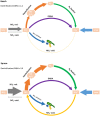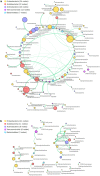Microbial communities with distinct denitrification potential in spruce and beech soils differing in nitrate leaching
- PMID: 28851897
- PMCID: PMC5575336
- DOI: 10.1038/s41598-017-08554-1
Microbial communities with distinct denitrification potential in spruce and beech soils differing in nitrate leaching
Erratum in
-
Author Correction: Microbial communities with distinct denitrification potential in spruce and beech soils differing in nitrate leaching.Sci Rep. 2018 Mar 14;8(1):4754. doi: 10.1038/s41598-018-22998-z. Sci Rep. 2018. PMID: 29540779 Free PMC article.
Abstract
Nitrogen leaching owing to elevated acid deposition remains the main ecosystem threat worldwide. We aimed to contribute to the understanding of the highly variable nitrate losses observed in Europe after acid deposition retreat. Our study proceeded in adjacent beech and spruce forests undergoing acidification recovery and differing in nitrate leaching. We reconstructed soil microbial functional characteristics connected with nitrogen and carbon cycling based on community composition. Our results showed that in the more acidic spruce soil with high carbon content, where Acidobacteria and Actinobacteria were abundant (Proteo:Acido = 1.3), the potential for nitrate reduction and loss via denitrification was high (denitrification: dissimilative nitrogen reduction to ammonium (DNRA) = 3). In the less acidic beech stand with low carbon content, but high nitrogen availability, Proteobacteria were more abundant (Proteo:Acido = 1.6). Proportionally less nitrate could be denitrified there (denitrification:DNRA = 1), possibly increasing its availability. Among 10 potential keystone species, microbes capable of DNRA were identified in the beech soil while instead denitrifiers dominated in the spruce soil. In spite of the former acid deposition impact, distinct microbial functional guilds developed under different vegetational dominance, resulting in different N immobilization potentials, possibly influencing the ecosystem's nitrogen retention ability.
Conflict of interest statement
The authors declare that they have no competing interests.
Figures




References
-
- Cleland EE, Harpole WS. Nitrogen enrichment and plant communities. Year in Ecology and Conservation Biology 2010. 2010;1195:46–61. - PubMed
-
- Kopacek J, et al. Nitrogen, organic carbon and sulphur cycling in terrestrial ecosystems: linking nitrogen saturation to carbon limitation of soil microbial processes. Biogeochemistry. 2013;115:33–51. doi: 10.1007/s10533-013-9892-7. - DOI
Publication types
MeSH terms
Substances
LinkOut - more resources
Full Text Sources
Other Literature Sources
Molecular Biology Databases

